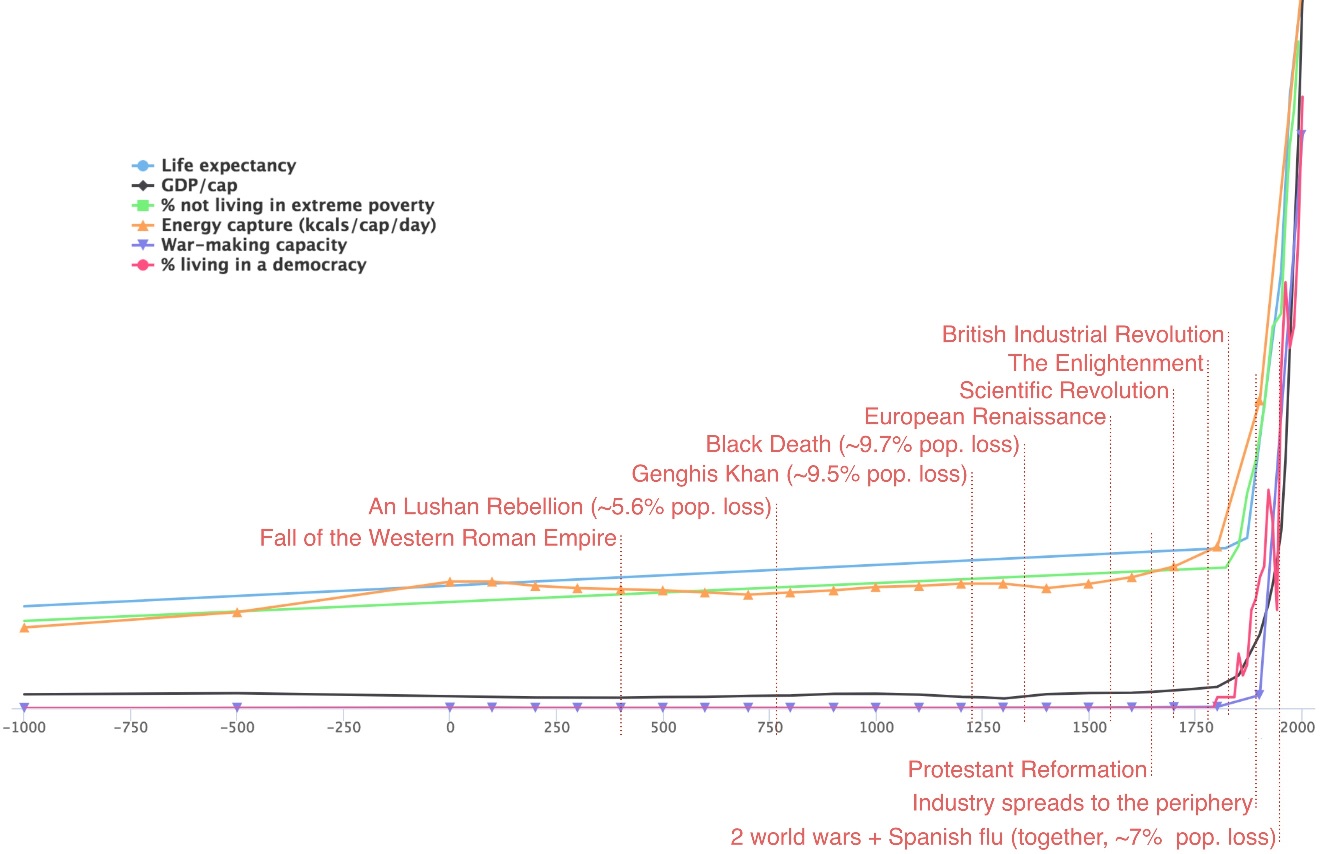At the start of this interview, I cite Economic Freedom of the World and the Index of Economic Freedom to make the point that more economic liberty is correlated with more human prosperity.
For purposes of today’s column, I want to focus on the last half of the interview. I point out that a handful of nations began to escape poverty, largely back in the 1800s, when the fiscal burden of government was very small.
But that’s just a partial explanation. As Professors Donald Boudreaux and Deirdre McCloskey explained in short videos, the adoption of capitalism in a few nations enabled a stunning increase in living standards starting a couple of hundred years ago.
If you want a one-sentence summary, all you need to know is that capitalism enabled the industrial revolution and the industrial revolution triggered a huge increase in living standards.
If you prefer to see this in a visual form, here’s a compelling chart put together by Luke Muehlhauser of the Open Philanthropy Project.
And here’s some of what he wrote on his personal page.
The gains in human well-being observed since the industrial revolution are vastly larger than pre-industrial fluctuations in human well-being. No other transitions in recorded history, either positive or negative, are remotely similar in magnitude. …world GDP per capita (in 1990 international dollars) was relatively flat until the final decades of the industrial revolution, when the trajectory for this measure changed dramatically. …
In general, the gains and losses in (these measures of) human well-being during the pre-industrial era are miniscule compared to the gains made during the post-industrial era, and there is a sharp upward trajectory change for all these measures shortly after 1800. …many major historical events seem to have not produced anything close to such a transformative change.
Let’s see what others have to say on this topic.
My former colleague Marian Tupy, in an article for the Foundation for Economic Education, pointed out that living through the industrial revolution was no picnic by today’s standards, but the wealth generated by free markets is what enabled environmental improvements.
It is well known that industrialization helped to pollute the environment, but that does not mean that air and water were clean before factories and mills came along! Compared to today, our ancestors had to endure horrific environmental conditions. …John Harrington invented the toilet in 1596, but bathrooms remained rare luxuries two hundred years later. Chamber pots continued to be emptied into streets, turning them into sewers. To make matters worse, even large towns continued to engage in husbandry well into the 18th century. As Fernand Braudel noted in The Structures of Everyday Life, “Pigs were reared in freedom in the streets. And the streets were so dirty and muddy that they had to be crossed on stilts.” …The situation was no better on the European mainland. …industrialization did great damage to the environment during the second half of the 19th century. But it also created wealth that allowed advanced societies to build better sanitation facilities and spurred the creation of an enlightened populace with a historically unprecedented concern over the environment and a willingness to pay for its stewardship.
Very similar to the issue of child labor.
Market-driven prosperity is what enabled children to go to school rather than being put to work.
In a column for the American Institute for Economic Research, Professor Vincent Geloso of King’s University College looked at new research about the rise of living standards as the United Kingdom went through the industrial revolution.
I began asking my own students about their assessments of the Industrial Revolution. The set of answers I obtained was roughly the same: living standards did not increase for the poor; only the rich got richer; the cities were dirty and the poor suffered from ill-health; the artisans were crowded out; the infernal machines of the Revolution dumbed down workers, etc. In other words, the imagery that seems to have seeped into popular imagination is one that resembles the Marxian version of history…
As such, any new research on the topic of living standards during the Industrial Revolution is worth communicating… Two recent articles, published in the European Review of Economic History, that consider living standards in Britain (the cradle of industrialization) during the Industrial Revolution offer such a chance…
The first of the two articles, authored by Luis Zegarra, made a series of modifications to the way that wages are deflated. …He made two important findings. The first is that living standards were lower than depicted in previous works of economic history. He found that living standards in London (i.e. a proxy for England) were overestimated by 40%. The second is that the increase in living standards was sustained from 1600 onwards.
The second article, authored by Daniel Gallardo-Albarrán and Herman de Jong, decided to go a step further and attempted to measure welfare as broadly defined as possible. …their results…show…the increase started later but there was a pronounced sustained increase.
P.S. Here’s a video about how industrialization dramatically improved lives in a country that used to be part of Britain.
P.P.S. And here’s another video on the link between free markets and growth.
P.P.P.S. If you want more historical information about the industrial revolution, click here and here.

No comments:
Post a Comment